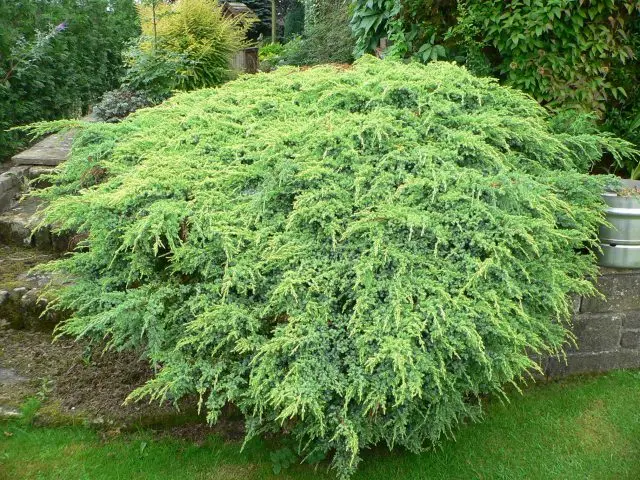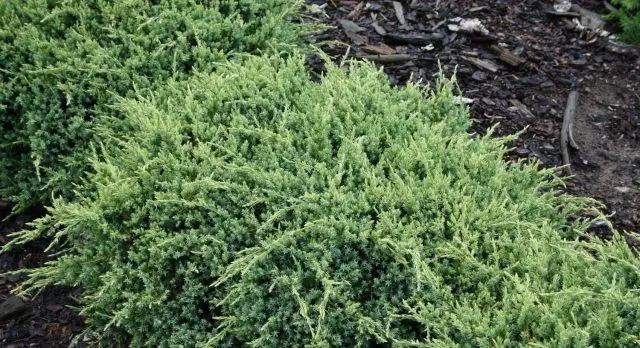Contents
Juniper scaly Holger is a perennial evergreen shrub. The historical homeland of the plant is the foothills of the Himalayas, a culture is found in East China and on the island of Taiwan. Thanks to the decorative habit shown in the photo, Holger scaly juniper is widely used in landscape design as a tapeworm and an element of various compositions.

Description of juniper scaly Holger
The scaly juniper Holger is a short, sprawling shrub with horizontal, drooping branches. The central shoots are straight-growing with sharp ends. The stem of the shrub is short, the lower branches are located strictly horizontally, low from the ground. They grow unevenly, the volume of the bush along the protruding tops of the lower stems is 1,5–1,7 m.
The duration of the biological cycle of scaly juniper is more than 200 years. Holger grows slowly, every year it adds up to 8-10 cm. In 10 years it grows up to 0,5 m, it is considered an adult. The end point of growth is 0,7 m. The size and decorativeness of the shrub depends on the location, the drought resistance of the culture is average, it does not tolerate dry air.
The best option for a comfortable growing season is partial shade near the reservoir. In a completely shaded area with high humidity, for example, under tall trees, the crown becomes sparse, the needles are smaller, constantly wet soil can cause the root system to rot and the plant will die.
Juniper scaly Holger is grown in all regions, except for the Far North. Frost resistance of the species is high enough to tolerate temperature drops to -35 0C. In case of damage to the shoots in the winter, the shrub is completely restored during the growing season.
External description of Holger scaly juniper:
- The diameter of the branches at the base is 3–4 cm. The surface is light gray, rough.
- The needles are needle-shaped at the base of the branches, scaly on young shoots, the arrangement is dense. The color of perennial needles is light green below, the upper part is with a blue tint, the needles on young shoots are bright yellow. By winter, the color does not change.
- Cone berries are steel-colored, medium-sized, formed every year, contain essential oils. Seeds in a cone – 2 pcs., Suitable for breeding juniper.
- The fibrous root system grows widely, is close to the surface.
Juniper scaly Holger in landscape design
Holger scaly juniper has a variegated tricolor color, bright decorative habit makes the culture attractive for professional designers and amateur gardeners. The plant is used for landscaping parks, squares, city flower beds and rabatok. This kind of culture is an essential attribute in the design solution for the design of heather gardens, garden plots, flowerbeds for the foreground of administrative buildings. In the photo – the use of Holger juniper in garden design.

The scaly juniper is used as a single plant, also planted to create compositions. The shrub looks aesthetically pleasing in combination with thuja, heather varieties. The shrub emphasizes the color of flowering plants, for example, roses, barberries, dimorphoteca. Harmonizes with dwarf pines and firs. Used for decoration:
- flower bed;
- slaves;
- coastal part of reservoirs;
- rocky slopes;
- planted near stones in rockeries;
- frame the hill of the rock garden.
Planting and caring for juniper scaly Holger
For juniper scaly Holger choose a sunny place, periodic shading is allowed. The plant is photophilous, responds well to dry air and moisture deficiency. Any soil composition is suitable, the main condition is that the soil should be light, drained, fertile.
Seedling and planting preparation
A seedling for planting is taken at the age of 3, it can be purchased or grown independently. If the root is open, before planting it is treated with a solution of manganese and placed in the Kornevin preparation to stimulate growth.
The place is dug up 2 weeks before planting, sand, peat and compost are added. The hole is dug taking into account the volume of the root system, it should be 10–15 cm wider, the depth should be 60–70 cm. The bottom is covered with a layer (20 cm) of drainage, gravel or broken bricks are used.
Rules of landing
If the scaly juniper Holger has an open root system, it is lowered into a thick solution of clay. Landing:
- Soil is poured into the holes, a small cone-shaped hill is made in the center.
- They put a seedling, carefully distribute the roots.
- Cover with earth, leaving 10 cm to the edge.
- Top fill the hole with sawdust.
- The root neck is not deepened.
If the root system is closed, dilute Kornevin in water, water the seedling. The trunk circle is mulched.
Watering and top dressing
The watering regime for scaly juniper is set in accordance with seasonal precipitation. The rate of moisture required for crop growth is 10 liters per day. If the plant is located far from the reservoir, in hot weather, it is necessary to sprinkle in the morning or evening. Holger is fed in the spring (before reaching the age of three) with complex mineral fertilizers. Mature shrubs do not need top dressing.
Mulching and loosening
After placing on the site, the soil around the seedling is mulched. For scaly juniper Holger, crushed tree bark is used. This composition of the mulch gives the appearance of an ornamental shrub aesthetics and retains moisture well. In autumn, the layer is increased with peat or straw. Update the mulch in the spring. Loosening is shown to young seedlings until the lower branches grow. The procedure is carried out as weeds grow.

Trimming and shaping
Juniper horizontal Holger gives a small annual increase. After the formation of the desired shape, it is maintained by a single pruning in the spring. Work is carried out before the start of sap flow. The shrub has a bright, lush crown, often left in its original form. In the spring, sanitary cleaning is carried out, areas frozen over during the winter are removed, dry shoots are cut off. I form the crown of the scaly juniper after the height of the seedling reaches 30 cm.
Preparation for winter
In autumn, the mulch layer is increased by 10 cm, young plants are spudded, then covered with straw. Mature plants are watered with a large volume of water. Scaly juniper is a frost-resistant culture, but the structure of the wood is rather fragile; under the weight of snow, the crown can break. In winter, the branches are lifted and fixed to the trunk with a tourniquet. Young plants are covered with spruce branches on top or wrapped with a cloth. In severe frosts, snow is thrown on the bush.
Reproduction of juniper Holger
Juniperus squamata Holger (scaly Holger) can be propagated on the site in several ways:
- Generative method. The culture produces full-fledged seeds that completely retain the varietal characteristics of the parent bush.
- Layers from the lower branches. To obtain a seedling in spring, the lower branch is fixed to the ground and covered with soil; by autumn it will take root.
- Cuttings from 2-year-old shoots, cut material 12-15 cm long.
Less commonly used is the grafting method on a stem of a tall seedling.
Diseases and pests
Juniper scaly is resistant to fungal and bacterial infection. It is not recommended to plant a crop near apple trees, the proximity to a fruit tree causes the development of needle rust. Of the garden pests on the shrub parasitize:
- Juniper sawfly. Upon detection, the crown is treated with Karbofos.
- Juniper often affects aphid, its appearance is provoked by ants. Eliminate pests as follows: cut off areas of the main localization of the colony, get rid of anthills.
- The scale insect parasitizes less often, the insect appears in dry weather with minimal air humidity. Destroy the scutes with insecticides.
For preventive purposes, Holger scaly juniper is treated with copper-containing preparations.
Conclusion
Juniper scaly Holger is a frost-resistant, unpretentious culture in care. The undersized shrub has a bright decorative habit. They grow culture in the European, Central part of Our Country. They are widely used in the design of the landscape of a personal plot, urban recreation areas, are used in design as a single plant and as part of a composition.









